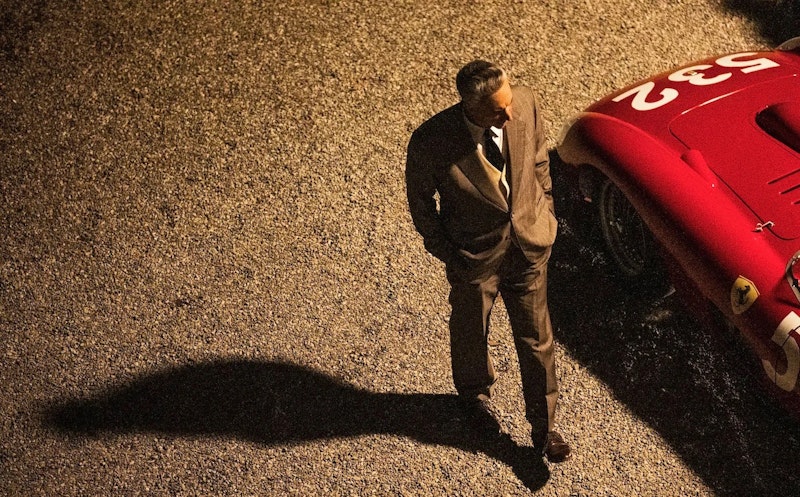Race car drivers once would rather be flung from a crash instead of riding out its metallic death. It was a final separation, attempting to break their fates at the last doomed minute. The automobile introduced a new capacity for speed, one which accelerates individual humans beyond previously imagined possibilities. It became the fixation of Italian Futurists; founding father F.T. Marinetti writing about the new “beauty of speed” in his manifesto, with those classic cigar-shaped grand prix car’s unyielding abilities comparing, in his eyes, to the incredible incessance of machine-gun fire. Man and machine fusing into something greater than the other, it was the start of a new world and the darkest inclinations of the 20th century. Metal and bodies fuse, they desperately try to hold each other together. Until they don’t, sending one flying and the other disintegrating.
Michael Mann’s Ferrari, a film he’s tried to get off the ground for almost three decades, is summed up by the updated subtitle of the biography it’s based on: the man and the machine (although the screenplay from the early-1990s is credited as being adapted from the original title of Brock Yates’ book: the man, the cars, the races). Most of Mann’s central figures are men living double lives, one side fighting for human love and compassion, the other being an unrelenting drive to achieve. Often that drive is couched in a desire to break away from systems keeping them down, building their own game with their own rules, thinking that if they just keep going the light will one day emerge at the end of the tunnel, like when the ethereal fluorescents consume the screen as Neil McCauley drives between the fulcrum of his dream life and tragic, human reality at the end of Heat.
Ferrari is a distillation. Taking place over a few months in 1957, Enzo’s life isn’t just unhealthily split between work and woman, his romantic life is split in half; secretly sharing time between a wife, Laura (Penelope Cruz), he’s become estranged from since their son’s tragic, untimely death the year before and his mistress, Lina (Shailene Woodley, with a horrific attempt at an Italian accent), whom he had a child with during the war. It’s a past and future that each holds the other back, irreconcilable yet inescapable. That inward keeps trying to break out against the mythic public image of Ferrari, the cruelly passionate industrialist so delicately realized by Adam Driver under Mann’s direction. Unlike so many driven Mann protagonists, Enzo has no discernable logical reason to do what he does. He builds cars to win, winning for the sake of winning (one might say, “the action is the juice”). It’s called into question every time the death toll mounts. When Maserati comes to Ferrari’s home turf, Modena, and breaks the record at their local autodrome, Enzo responds by putting his own driver on track after mass, pushing him to the point of car failure, sending his metal machine crumpling into a concrete construction and the pilot’s body across the tarmac. It’s a pointless death, a drive for the idea of driving.
The film’s narrative crux rides on Ferrari beating (humiliating) Maserati at the Mille Miglia, that great thousand-mile race making a band (fascia, in Italian) around a united Italy as sports cars race from Lombardian Alps all the way down to Rome, wrapping around the Colosseum and back to the North. It was first run in 1927, by a pair of counts who were apparently upset that the Italian Grand Prix was moved from their hometown of Brescia to the newly-constructed (and first-purpose built) Autodromo di Monza. Their figure-eight race around the breadth of the peninsula would be a mechanical incarnation of the Risorgimento, a people linked together by the new possibilities of man-made speed. Mann captures this rugged, ridiculous race by making metal machines seem heavier than they’ve ever been before at over 100 miles an hour. Tires scream as the rear suspension tries to fight them through corners and as the chassis seems like it’s about to tear itself to bits. It’s loud, as you expect from Mann, and the bolts and bits of the cars have as much terrible weight as the melodrama surrounding the man’s life.
It’s a near-impossible task to make a truthful film about Enzo Ferrari’s life because of what he left behind: one of the most prestigious and tightly-controlled brands in the world. In order to make a film about Enzo, let alone get incredible access to his family and factories, Mann has to toe the line between what’s on screen and what’s implied by Enzo’s history. The film can’t give any more than a passing mention that Ferrari was building engines for airplanes in WWII, which means he was supplying Mussolini’s fascists (in fact, the company’s factory was first moved from Modena to its famous spot in Maranello to try to avoid Allied bombing raids). Enzo, like so many in motorsports after World War I, was an early, eager supporter of Mussolini, and many have noted that Enzo proudly wore a blackshirt uniform. The traces of Ferrari’s fascism are imbued in the structure of his company, with his many underlings calling him commendatore and bowing down to his ultimate vision. Everything he does, everyone he commands, is in service of a mythos—not a strictly nationalist one like Mussolini’s, although that’s an element—that Ferrari is nothing but primo. The F1 slogan “forza Ferrari” and its English translation of “Ferrari power” are eerie given the undeniable past that lives on through a logo. What Mann’s Ferrari tries to do is break down this image, give humanity to what tries to make itself inhuman, thereby undermining the vision, but only insofar as its imaginary elements. What’s left isn’t an idea, a concept, or brand that can be obsessively fought over to the point of abstraction, but men and machines.

